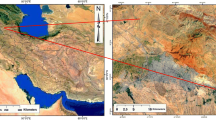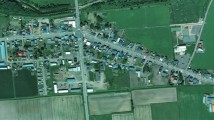Abstract
Meteorite impacts participated in the formation of the Solar System and continue to modify the planetary surfaces, originating a structure present in all of them, the craters. Terrestrial craters are abundant, geological and biological significant structures and are related to large mineral ores. The Earth impact record continues to be deciphered, currently 190 terrestrial impact structures have been confirmed, and it is estimated that several hundred remain to be discovered. One of the techniques to detect a crater candidate site is Remote Sensing, however it is a difficult task, due to the large information that must be processed, the lack of discriminant features for crater and non-crater regions and appropriated methods to recognize them. We propose an approach to identify meteorite impact structures, based on textural features of ALOS/PALSAR grayscale radar images, using supervised automatic learning. For this, the quotient of HV and HH polarimetric bands of these images was calculated. The resulting images were segmented by global thresholding to generate two sets of training samples: structure type and regions type of craters and non-craters, with them different kinds of classifiers (Bayesian, Fuzzy, Genetics, Bagging, and Boost) were trained, getting accuracy between 81 to 99% for craters identification.
Access this chapter
Tax calculation will be finalised at checkout
Purchases are for personal use only
Similar content being viewed by others
References
KrØgli, S.O., Dypvik, H., Etzelmüller, B.: Automatic detection of circular depressions in digital elevation data in the search for potential Norweigian impact structures. Norwegian J. Geol./Norsk Geologisk Forening 87, 157–166 (2007)
de Alburquerque Aráujo, A., Hadad, R., Pereira Martins, P.J.: Identification of patterns in satellite imagery: circular forms. In: Dougherty, E.R., Astola, J.T., (eds.) Nonlinear Image Processing and Pattern Analysis XII, vol. 4304, pp. 25–35. SPIE-International Society for Optical Engine (2001). https://doi.org/10.1117/12.424989
Portugal, R.S., de Souza Filho, C.R.: Automatic crater detection using DEM and circular coherency analysis - a case study on South American craters. In: 67th Annual Meteoritical Society Meeting on Proceedings, Rio de Janeiro, Brazil, no. 5096 (2004)
Bruzzone, L., Lizzi, L., Marchetti, P.G., Earl, J., Milnes, M.: Recognition and detection of impact craters from EO products. In: Proceedings of the Conference “ESA-EUSC 2004”, ESA Publications Division, Madrid, Spain (2004)
Earl, J., Chicarro, A., Koeberl, C., Marchetti, P.G., Milnes, M.: Automatic recognition of crater-like structures in terrestrial and planetary images. In: 36th Annual Lunar and Planetary Science Conference, League City, Texas, USA, p. 1319 (2005)
Liu, S., Ding, W., Gao, F., Stepinski, T.F.: Adaptive selective learning for automatic identification of sub-kilometer craters. Neurocomputing 92, 78–87 (2012)
Earth Impact Database. https://www.passc.net/EarthImpactDatabase, Accessed 1 Jan 2018.
The collapse caldera worldwide database. https://www.gvb-csic.es/CCDB/, Accessed 1 Jan 2018
Smithsonian Institution-Global Volcanism Program. https://volcano.si.edu/, Accessed Jan 2018
Volcano Table-Volcano World-Oregon State University. https://volcano.oregonstate.edu/volcano_table, Accessed 1 Jan 2018
Global PALSAR-2/PALSAR/JERS-1 Mosaic and Forest/Non-Forest map. https://www.eorc.jaxa.jp/ALOS/en/palsar_fnf/data/index.htm, Accessed 1 Dec 2017
Simental, E., Guthrie, V., Blundell, S.B.: Polarimetry band ratios, decompositions, and statistics for terrain characterization. In: Global Priorities in Land Remote Sensing on Proceedings of the Pecora, vol. 16, pp. 23–27. American Society for Photogrammetry and Remote Sensing, Sioux Falls (2005)
MVTec Halcon 10.0, version 2014; MVTec software GmbH. https://www.mvtec.com
van Gasselt, S., Kim, J., Choi, Yun-Soo., Kim, J.: The Oasis impact structure, Libya: geological characteristics from ALOS PALSAR-2 data interpretation. Earth Planets Space 69(1), 1–12 (2017). https://doi.org/10.1186/s40623-017-0620-8
Thapa, R.B., Watanabe, M., Motohka, T., Shimada, M.: Potential of high-resolution ALOS–PALSAR mosaic texture for aboveground forest carbon tracking in tropical region. Remote Sens. Environ. 160, 122–133 (2015)
Rakwatin, P., Longépé, N., Isoguchi, O., Shimada, M., Uryu, Y., Takeuchi, W.: Using multiscale texture information from ALOS PALSAR to map tropical forest. Int. J. Remote Sens. 33(24), 7727–7746 (2012)
Singh, M., Kaur, G.: SAR image classification using PCA and texture analysis. In: International Conference on Advances in Information Technology and Mobile Communication Proceedings, pp. 435–439. Springer, Heidelberg (2011)
Freund, Y., Schapire, R.E.: Experiments with a new boosting algorithm. In: Saitta, L., Kaufmann, M. (eds.) 13th International Conference on Machine Learning, vol. 96, pp. 148–156 (1996)
Breiman, L.: Bagging predictors. Mach. Learn. 24(2), 123–140 (1996)
Aha, D.W., Kibler, D., Albert, M.K.: Instance-based learning algorithms. Mach. Learn. 6(1), 37–66 (1991)
Jensen, R., Cornelis, C.: A new approach to fuzzy-rough nearest neighbor classification. In: Chan, C.C., Grzymala-Busse, J.W., Ziarko, W.P. (eds.) 6th International Conference, RSCTC, pp. 310–319. Springer, New York (2008)
Koza, J.R.: Genetic Programming: On the Programming of Computers by Means of Natural Selection. MIT Press, New York (1992)
Banzhaf, W., Nordin, P., Keller, R.E., Francone, F.D.: Genetic Programming: An Introduction: On the Automatic Evolution of Computer Programs and Its Applications. Morgan Kaufmann Publishers Inc., San Francisco (1998)
John, G.H., Langley, P.: Estimating continuous distributions in bayesian classifiers. In: Besnard, P., Hanks, S. (eds.) Uncertainty in Artificial intelligence 1995, pp. 338–345 (1995)
Waikato Environment for Knowledge Analysis (WEKA), Version 3.6.12: The University of Waikato, Machine Learning Group at the University of Waikato (2014). https://www.cs.waikato.ac.nz/ml/weka/downloading.html
Abate, B., Koeberl, C., Kruger, F.J., Underwood Jr., J.R.: BP and oasis impact structures, libya, and their relation to libyan desert glass. In Dressler, B.C., Sharpton, V.L. (eds.) Large Meteorite Impacts and Planetary Evolution II, pp. 177–192. Geological Society of America Inc. (1999)
Orti, L., Di Martino, M., Morelli, M., Cigolini, C., Pandeli, E., Buzzigoli, A.: Non-impact origin of the crater-like structures in the Gilf Kebir area (Egypt): Implications for the geology of Eastern Sahara. Meteorit. Planet. Sci. 43(10), 1629–1639 (2008)
El-Baz, F., Ghoneim, E.: Largest crater shape in the Great Sahara revealed by multispectral images and radar data. Int. J. Remote Sens. 28(2), 451–458 (2007)
Svetsov, V., Shuvalov, V., Kosarev, I.: Formation of Libyan desert glass: numerical simulations of melting of silica due to radiation from near-surface airbursts. Meteorit. Planet. Sci. 55(4), 895–910 (2020)
Author information
Authors and Affiliations
Corresponding author
Editor information
Editors and Affiliations
Rights and permissions
Copyright information
© 2021 Springer Nature Switzerland AG
About this paper
Cite this paper
Jimenez-Martinez, N., Diaz-Hernandez, R., Ramirez-Cardona, M., Altamirano-Robles, L. (2021). Texture Based Supervised Learning for Crater-Like Structures Recognition Using ALOS/PALSAR Images. In: Roman-Rangel, E., Kuri-Morales, Á.F., Martínez-Trinidad, J.F., Carrasco-Ochoa, J.A., Olvera-López, J.A. (eds) Pattern Recognition. MCPR 2021. Lecture Notes in Computer Science(), vol 12725. Springer, Cham. https://doi.org/10.1007/978-3-030-77004-4_28
Download citation
DOI: https://doi.org/10.1007/978-3-030-77004-4_28
Published:
Publisher Name: Springer, Cham
Print ISBN: 978-3-030-77003-7
Online ISBN: 978-3-030-77004-4
eBook Packages: Computer ScienceComputer Science (R0)





